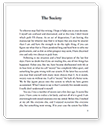Biotechnology Essays and Research Papers
Instructions for Biotechnology College Essay Examples
Title: Biotechnology Business focused on Charles River Laboratories
Total Pages: 20 Words: 5076 References: 8 Citation Style: APA Document Type: Research Paper
Title: Biotechnology
Total Pages: 2 Words: 597 Works Cited: 0 Citation Style: MLA Document Type: Essay
Title: Biotechnology
Total Pages: 2 Words: 675 Bibliography: 0 Citation Style: MLA Document Type: Research Paper


